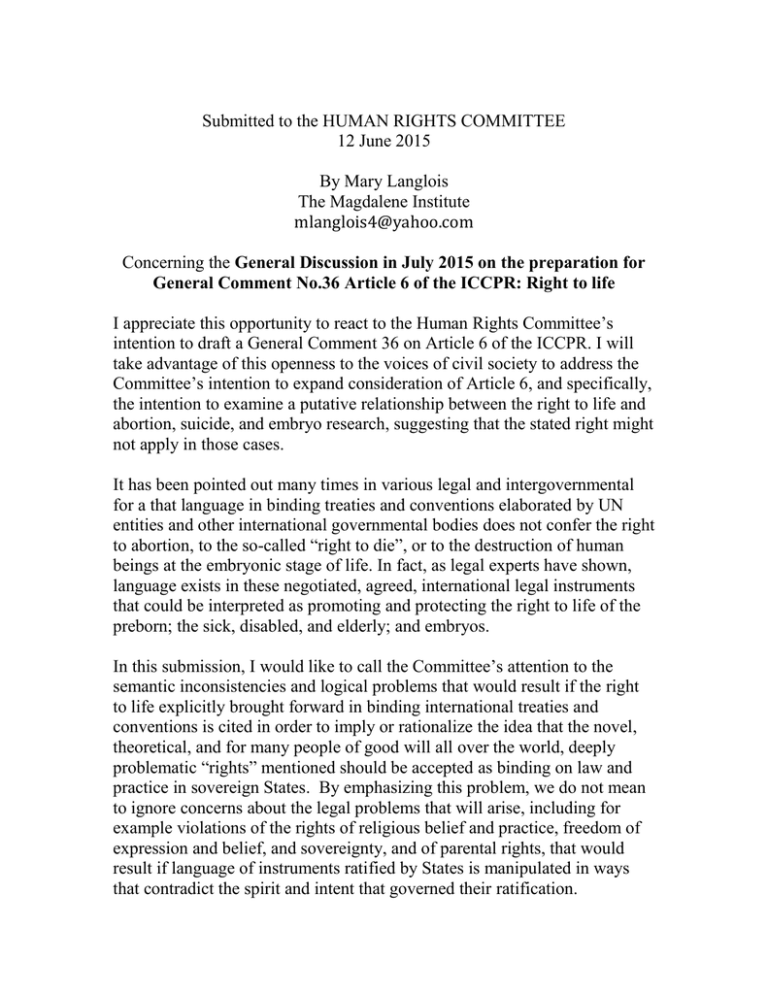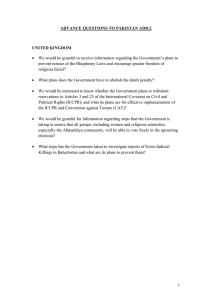Submitted to the HUMAN RIGHTS COMMITTEE 12 June 2015 By Mary Langlois
advertisement

Submitted to the HUMAN RIGHTS COMMITTEE 12 June 2015 By Mary Langlois The Magdalene Institute mlanglois4@yahoo.com Concerning the General Discussion in July 2015 on the preparation for General Comment No.36 Article 6 of the ICCPR: Right to life I appreciate this opportunity to react to the Human Rights Committee’s intention to draft a General Comment 36 on Article 6 of the ICCPR. I will take advantage of this openness to the voices of civil society to address the Committee’s intention to expand consideration of Article 6, and specifically, the intention to examine a putative relationship between the right to life and abortion, suicide, and embryo research, suggesting that the stated right might not apply in those cases. It has been pointed out many times in various legal and intergovernmental for a that language in binding treaties and conventions elaborated by UN entities and other international governmental bodies does not confer the right to abortion, to the so-called “right to die”, or to the destruction of human beings at the embryonic stage of life. In fact, as legal experts have shown, language exists in these negotiated, agreed, international legal instruments that could be interpreted as promoting and protecting the right to life of the preborn; the sick, disabled, and elderly; and embryos. In this submission, I would like to call the Committee’s attention to the semantic inconsistencies and logical problems that would result if the right to life explicitly brought forward in binding international treaties and conventions is cited in order to imply or rationalize the idea that the novel, theoretical, and for many people of good will all over the world, deeply problematic “rights” mentioned should be accepted as binding on law and practice in sovereign States. By emphasizing this problem, we do not mean to ignore concerns about the legal problems that will arise, including for example violations of the rights of religious belief and practice, freedom of expression and belief, and sovereignty, and of parental rights, that would result if language of instruments ratified by States is manipulated in ways that contradict the spirit and intent that governed their ratification. Language on the right to life is found in many places in UN, regional, and national treaty language, as has been amply demonstrated, but it should be pointed out that language that treats positively the right to life in the context of abortion; that is, the right to life from conception to birth, appears in such instruments as well. A few selections of such language follow, but the list here is not exhaustive. Two examples of a more detailed analysis of this issue by legal experts are Alliance Defending Freedom, submission to the Committee on this topic (pcoleman@adfinternational.org) and the San Jose Articles (www.sanjosearticles.com). The Convention on the Rights of the Child (CRC), preamble: “The child, by. reason of his physical and mental immaturity, needs special safeguards and care, including appropriate legal protection, before as well as after birth.” CRC, Article 6: “States Parties recognize that every child has the inherent right to life, and that States Parties shall ensure to the maximum extent possible the survival and development of the child.” The American Convention on Human Rights, Article 4(1): “Every person has the right to have his life respected. This right shall be protected by law and, in general, from the moment of conception. No one shall be arbitrarily deprived of his life.” In its General Comment on Article 6, the Human Rights Committee noted that, “The right to life has been too often narrowly interpreted. The expression ‘inherent right to life’ cannot properly be understood in a restrictive manner, and the protection of this right requires that States adopt positive measures, including those aimed at reducing the deaths of infants.” The language under consideration in Article 6 of the ICCPR is “Every human being has the inherent right to life.” Obviously, this formulation is not restrictive. That is not contested. And indeed, text that addresses such a fundamental concept as the right to life needs to be generalized, which speaks to a point I would like to make. It is not restrictive to promote the right to life of children before birth, any more than it is especially expansive to promote “reducing the deaths of infants”, that is to say of children after birth. It is in fact restrictive to exclude a certain group of children by suggesting that the right to life might be negotiable for them. I am referring to children, no matter their gestational age, in the womb. Nor is it restrictive to insist that the right to life applies fully to persons who are mired in depression, desperation, illness, or despair. Suicide robs them of life when they should instead have access to psychological, medical, palliative, and/or social support to alleviate their suffering. But again, it is in fact restrictive to single out this particular group as potential candidates for reviewing whether the right to life means the same thing for them as it does for healthy persons. Finally, science demonstrates what common sense has always asserted: the life of an individual human being begins at the moment when he or she comes into being as that individual human being, at conception/fertilization1. These tiny human beings are completely voiceless and without defenders, unless our nations and intergovernmental bodies take it upon ourselves to defend them. The cultural health of communities should not be based on their technological superiority, but on their respect for life and their concern for the most vulnerable. The General Assembly of the United Nations recognized the bioethical problems inherent in human cloning and passed a convention banning it, the European nations spoke decisively and in great number in asserting the rights of embryonic human beings (One of Us), and the Court of Justice of the European Union prohibited the destruction of human embryos. In questioning, in a restrictive manner, the right to life of this group of defenseless human beings, the Committee again risks setting up a contradiction that will impede the exercise of sovereign rights within the States. The right to life should be understood in its broadest sense and is widely and authoritatively defended in international legal instruments and other influential mechanisms. My organization calls on the Human Rights Committee to rely on the most rigorous and intellectually honest interpretation of the language as it appears in the ICCPR, respecting the common understanding of the language used as mandated in the Vienna Convention, so as to avoid introducing contradiction and confusion, the latter which will only serve to restrict the right to life for certain persons. Condic, Maureen. When does human life begin? A scientific perspective. Westchester Institute, Volume 1, Number 1. Oct. 2008. 1


